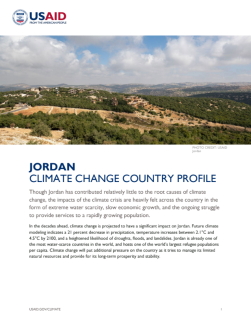In the decades ahead, climate change is projected to have a significant impact on Jordan, including a decrease in precipitation, temperature increases, and a heightened likelihood of droughts, floods, and landslides. Jordan is already one of the most water-scarce countries in the world, and hosts one of the world’s largest refugee populations per capita. Climate change will put additional pressure on the country as it tries to manage its limited natural resources and provide for its long-term prosperity and stability.
Government of Jordan Climate Priorities
The Government of Jordan presented its updated Nationally Determined Contribution (NDC) to the United Nations Framework Convention on Climate Change (UNFCCC) in 2021. The NDC links to objectives in the country’s National Adaptation Plan and has provisions for vulnerable groups including refugees, unemployed people, and people with disabilities. The NDC Action Plan emphasizes adaptation and mitigation actions, prioritized in key sectors for climate action in Jordan— namely transport, energy, agriculture, health, and water. To date, the country’s energy sector has been responsible for most greenhouse gas emissions, followed by the waste sector, industrial processes, and agriculture.
Jordan aims to address economic, social, health and environmental challenges through the development and implementation of a Long-Term Low-Carbon and Climate Resilient Strategy (LTS). With the long-term objective of aligning development goals with climate ambition, this comprehensive and inclusive plan presents an opportunity for the country to implement robust climate measures while navigating green economic growth and recovery. Meanwhile, the country’s 2022 National Adaptation Plan includes gender and youth mainstreaming in order to reduce those groups’ vulnerability to climate impacts.
In 2022, the Government of Jordan also released its 2022-2050 Climate Change Policy, which serves as an all-encompassing framework for integrating climate change considerations into all sectoral policies, strategies, and action plans. This policy emphasizes climate-resilient development that aligns with the global effort to achieve carbon neutrality by 2050. In support of this effort, in 2023, the Government of Jordan submitted its fourth NDC to the UNFCCC.
USAID’S Climate Change Program: Objectives and Results
USAID collaborates with the Government of Jordan to implement the National Climate Change Policy 2022-2050, Economic Modernization Vision, National Adaptation Plan, and the country’s NDCs. As a core donor in key target sectors such as water, energy, transport, tourism, agriculture, and waste management, USAID also empowers the country to make climate-smart investments, strengthen regional cooperation, and leverage domestic resources to combat the effects of climate change.
USAID’s water programming significantly reduces water loss and helps curb the sector’s CO2 emissions. USAID supports the Government of Jordan in enhancing water efficiency and conservation, reducing non-revenue water, upgrading water infrastructure, increasing water supply, and improving access to science and analysis for decision-making in climate-sensitive areas or sectors.
Additionally, USAID is establishing effective governance systems to address climate-related risks. USAID is involved in building climate-resilient schools, hospitals, water and energy infrastructure, and tourism sites, while expanding the country’s use of renewable energy sources. USAID is also contributing to the expansion of recycling services, developing climate curricula, fostering environmental leadership programs within the public sector, and engaging youth in advocacy and green entrepreneurship. Furthermore, USAID supports efforts to raise public awareness about climate change in Jordan, mitigate the impact of emerging infectious diseases exacerbated by climate change, and enhance climate resilience in urban areas.
Key Results
USAID has helped:
- Invest more than $600 million to assist water sector partners in reducing water loss and strengthen water network infrastructure
- Pledge $300 million—and is working to leverage more than $2 billion from donors and financiers for the National Conveyance Project (NCP)—to fight Jordan’s water scarcity; the NCP will feature a desalination plant on the Red Sea coast and a 450-kilometer pipeline from Aqaba to Amman that will eventually supply up to 40 percent of the country’s water needs
- Support the rehabilitation of the Zara Ma’in Water Supply System through installing 25 new water pumps, providing approximately 1.7 million people in Amman with access to constant water supply; through increased energy efficiency, the new pumps are projected to pay for themselves by October 2025
- Launch a $35 million water efficiency and conservation initiative, targeting 70 million cubic meters in water savings over the lifetime of the activity—equivalent to the annual drinking water needs of approximately 2 million people
- Enhance renewable energy utilization, grid resiliency, and sustainability by working with the Ministry of Energy and Mineral Resources, National Electric Power Company, and the Energy and Minerals Regulatory Commission
- Ensure funding is allocated for climate change priorities in annual budgets within ministries by working with the Government of Jordan at the policy level
- Support the development and launch of an early warning system that will help municipalities set adaptive emergency plans to preempt natural disasters
- Support the diversion of 78 tons per day of solid waste from landfills through improving the 3R practices (reduce, reuse, recycle), which contributed to a reduction in greenhouse gas emissions equivalent to 78 tons CO2 per year
- Facilitate action against water theft and environmental pollution cases through collaboration with the Ministry of Water and Irrigation and the Ministry of Environment, which involved linking their systems to the court system and providing training to judicial staff on relevant laws
- Implement green building best practices—including energy efficiency, water saving, insulation, and proper building orientation—by funding the construction of 30 new schools, rehabilitating and expanding another 30 schools, renovating the existing obstetrics and neonatal care hospital at Al Bashir Hospital complex, and constructing a maternity hospital at the King Hussein Medical Center
- Provide 1,200 vulnerable families with solar water heaters—helping them reduce both their monthly energy bills and greenhouse gas emissions—through the Renewable Energy for Vulnerable Households Activity, a partnership between USAID, the private sector, and the Jordan Renewable Energy and Energy Efficiency Fund
- Support the development of educational materials, empower water conservation trainers, and establish a training room equipped for water conservation learning through USAID Water Efficiency and Conservation, a 15-month grant agreement with the Jordan Boy Scouts and Girl Guides Association; through this initiative, 5,000 scouts and guides will participate in educational programs, training workshops, and community outreach activities




